According to statistics from Clutch, 83% of small businesses will maintain or increase their spending on outsourced business services in 2023. And IT outsourcing is among the top three most popular requests, alongside marketing and design.
Businesses outsource IT tasks for numerous reasons: to cut costs during times of recession, to focus on strategic goals, and simply because during the pandemic we all learned that managing remote teams efficiently is possible.
However, IT outsourcing comes in different forms, or, to be more specific, cooperation models. Based on our 10-year experience in providing IT outsourcing services, we prepared this guide to help you figure out which one suits your business best — and put your project in motion.
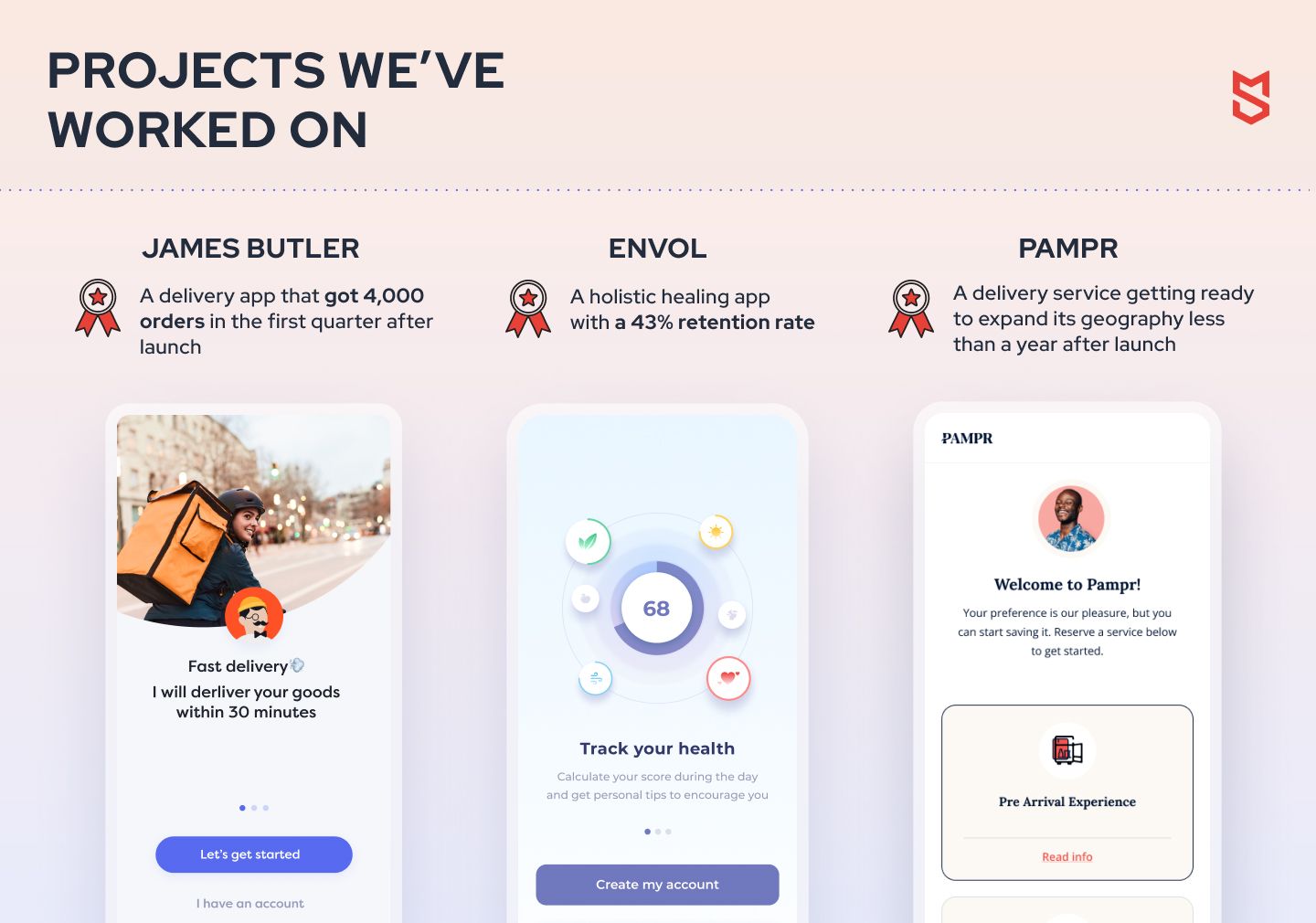
What is IT outsourcing?
“IT outsourcing is the use of external service providers to effectively deliver IT-enabled business process, application service and infrastructure solutions for business outcomes.”
This IT outsourcing definition by Gartner is perfectly accurate. Let us elaborate.
At Mind Studios, we view IT outsourcing as an efficient way for in-house teams to focus on business growth while delegating its technical aspect to professionals who can assist with reaching strategic goals through software solutions.
For example, while an outsourced development team finds a way to optimize your operational costs or works on new features, your internal specialists can dedicate their time to improving the product, marketing it, and working with customers. Ideally, an in-house team and an outsourced team work in synergy for the sake of business success.
Tech needs usually vary from business to business. Some can outsource all tech-related processes at once, while others look for partners who can accelerate time to market or provide expertise their in-house teams lack.
As a result, multiple IT functions can be outsourced, such as app development, help desk and tech support, infrastructure management, cybersecurity, quality assurance, and so on.
Our team is ready to provide not just custom software development services but also software audit, software re-engineering and support, business analysis and IT consulting, and IT staff augmentation.
Different types of IT outsourcing services
We’ve already briefly mentioned that businesses outsource various kinds of IT services. These functions are the first way to categorize outsourcing by type. When looking for a software development partner, you can also look into different options depending on the team’s geographical location and the cooperation model that suits your needs.
Location-based IT outsourcing types
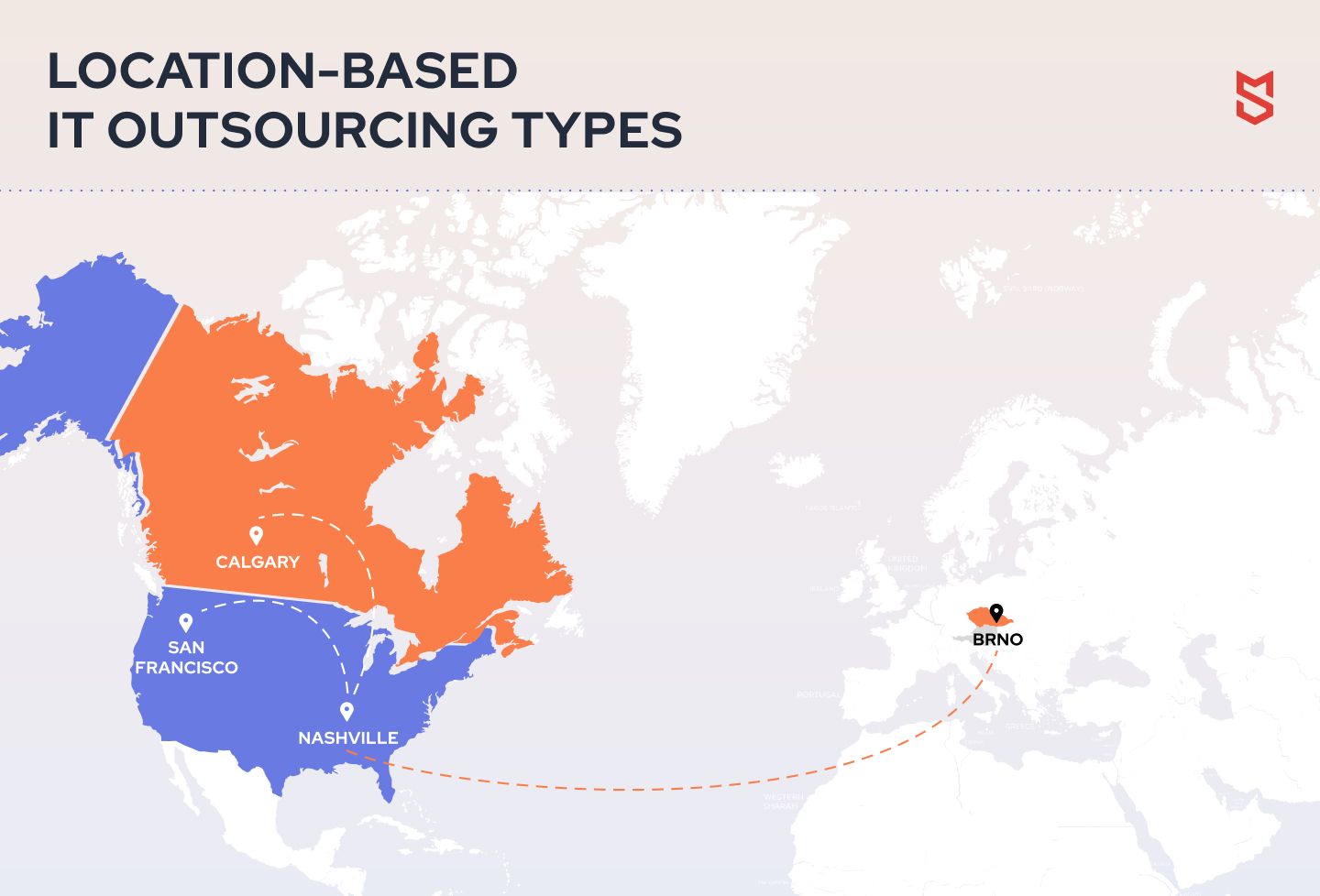
One of the first things to consider when choosing an outsourcing partner is the geographical location, which can fundamentally change the project price and the cooperation specifics. Here are the three types of outsourcing by geography.
Onshore
As a rule, an onshore team is located in the same country or even city you conduct business in.
While this option can be quite expensive, especially if we are talking about countries with high software development rates like the US, it allows your in-house and outsourced teams to collaborate onsite. Moreover, this way, you eliminate the risks like language and cultural barriers often associated with outsourcing.
Nearshore
A nearshore outsourced team is typically located in another country, but one that is close, meaning it has compatible time zones and can even allow for easy travel between two locations.
For instance, for US-based companies, it can be Canada or Mexico, while for Western European companies a nearshore outsourcing partner would be in Central or Eastern Europe.
Offshore
An offshore outsourced company can be located anywhere in the world, from Eastern Europe to the Philippines or Argentina, depending on your own location.
Despite significant time differences, cultural barriers, and other challenges, businesses use this option if it allows them to cut costs while getting access to top talent. That is because, for instance, for businesses from the US or Canada, offshore companies from Europe or Asia have significantly lower rates for specialists of the same level of expertise than onshore ones.
In one of our articles, we get into the specifics of hiring and successfully working with remote developers.
Cooperation-based IT outsourcing types
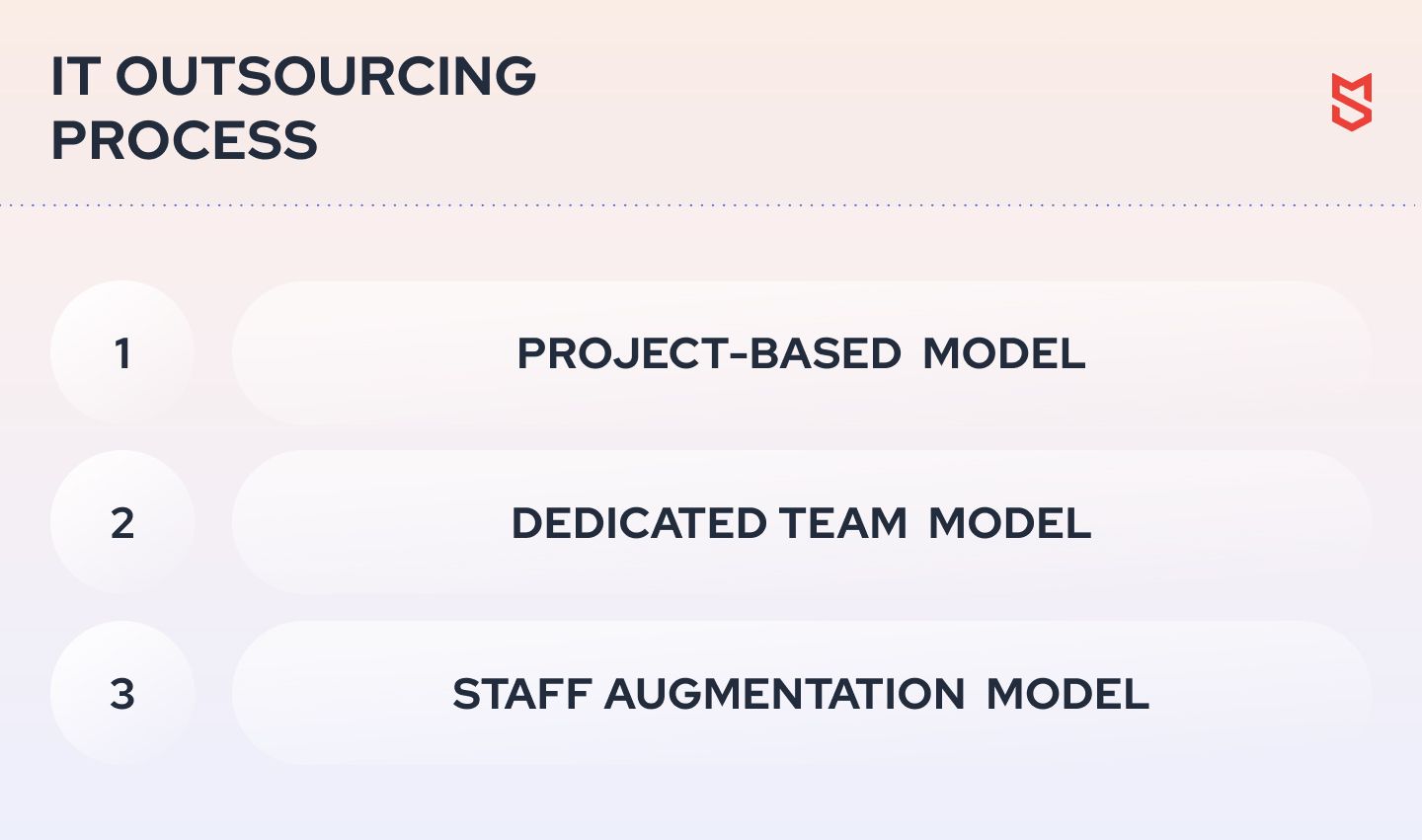
The choice of IT outsourcing models depends on the scale, budget, and end goals of the project. Here are the most common options to consider.
Project-based model
This cooperation type suits projects that already have a clear plan in motion and involve a fairly simple, predictable development process with strictly defined timelines.
Typically, in this case, the client hires an outsourced partner to deliver part of the project and has little involvement in the process. The outsourced team mostly communicates with the project manager on their side, who is responsible for the timely and adequate delivery of the solution.
Dedicated team model
When hiring a dedicated team for the project, the clients ensure the outsourced specialists will be highly engaged in building their product. For instance, at Mind Studios, we don’t share specialists on a dedicated team with other projects, meaning the client’s tasks are their only priority.
Unlike the project-based model, this type of cooperation suits early-stage startup owners who want to validate their idea or develop an MVP to test it. The dedicated team model can also be perfect for complex long-term projects and projects that don’t yet have a clearly defined business and development strategy.
The dedicated team doesn’t really work closely with the clients’ in-house team but often reports to their project managers, CTO, or directly to the clients.
Staff augmentation model
The staff augmentation model is another augment an in-house team with outsourced specialists comes in handy when you already have a project in motion but need to scale quickly or your team lacks a certain expertise. For instance, your team might have software engineers, but none of them have in-depth knowledge of working with artificial intelligence tools or IoT technologies.
In this case, instead of going through a lengthy and costly process of hiring additional specialists full-time, businesses can partner with outsourcing companies and access the needed experts quicker and for less money. After that, though temporarily, the outsourced specialists become part of the client’s in-house team.
Additionally, you can categorize IT outsourcing into different types by the financial cooperation model. Find out more about those in our article.
Pros and cons of IT outsourcing services
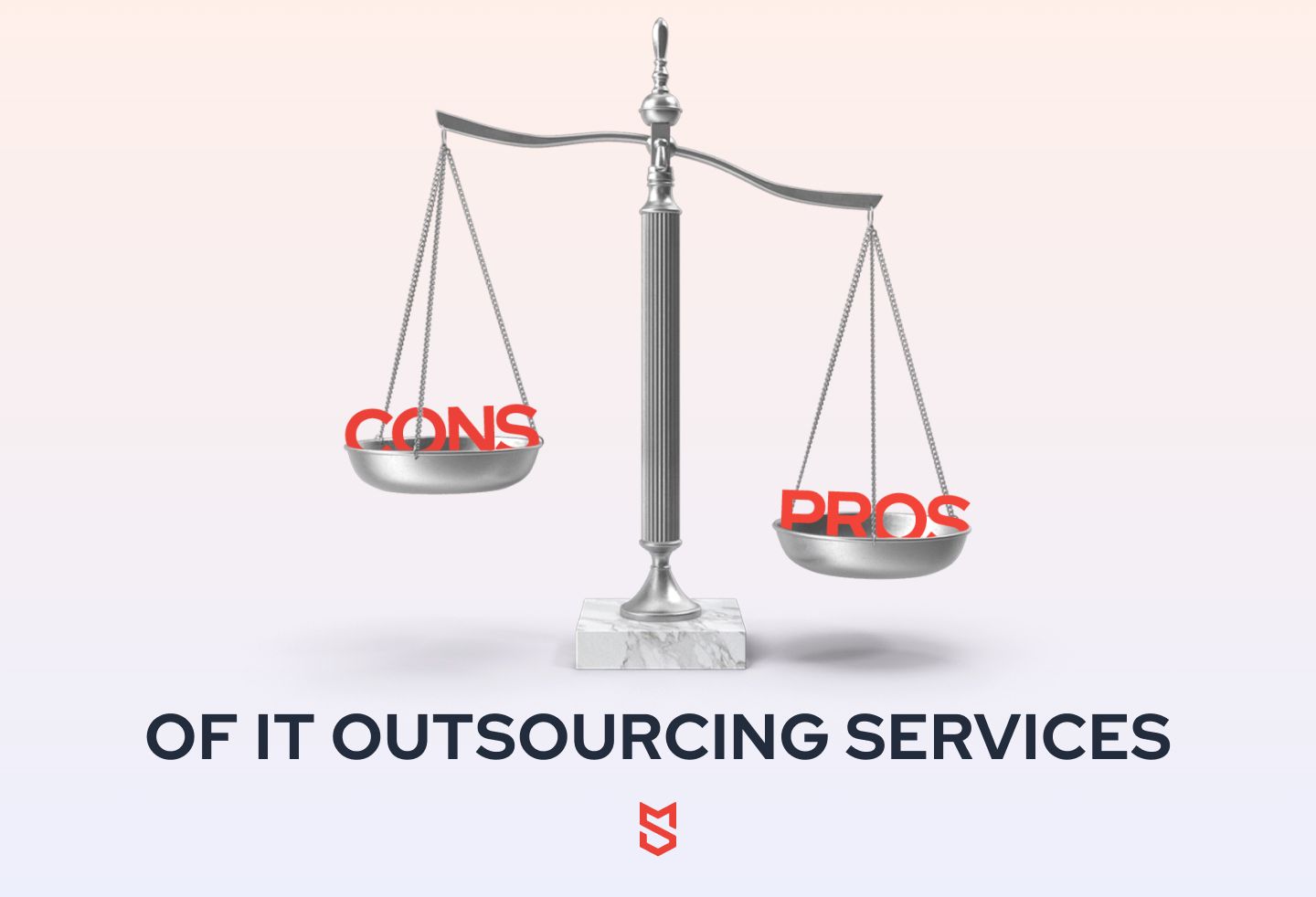
Drawbacks and advantages of IT outsourcing highly depend on its above-mentioned types. However, certain things are true regardless of the cooperation model you choose, So, let’s review the most significant IT outsourcing pros and cons.
Pros of IT outsourcing
Cost efficiency
The primary reason businesses outsource IT services is to cut costs. Hourly rates for software development services vary drastically due to the difference in salaries. For instance, according to Glassdoor, in the US, the average annual salary of iOS developers is close to $100,000, while in Poland, this number is around $28,000.
Obviously, partnering with a company from regions like Eastern Europe or Southeast Asia will be the most cost-effective solution. However, outsourcing to an onshore company is still less expensive than hiring and retaining in-house IT specialists since you won’t be the one paying for various administrative expenses, taxes, social benefits, and so on.
Access to global top talent
Lower costs don’t mean lower quality. One of the biggest IT outsourcing benefits is access to incredibly skilled specialists with diverse experience and in-depth expertise of the various technologies and industries.
Moreover, if you need to scale your project quickly and lack certain expertise, it is much easier to outsource since finding and hiring full-time specialists can be time-consuming.
Opportunity to focus on business goals
Outsourcing IT services allows businesses to delegate the tech management and focus on their primary competencies and strategic goals, be it growing customer base, developing new products, or establishing new B2B partnerships.
The outsourcing option is especially sensible if your company is not a tech one and doesn’t have experts with in-depth knowledge of IT processes.
Cons of IT outsourcing
Communication and control challenges
Language barriers, contrasting cultural backgrounds, and time zone differences can complicate communication between the in-house and the outsourced teams.
In addition, it might be harder to manage remote developers and maintain control over the project, particularly when working with freelancers. Therefore, it’s crucial to establish communication and development process guidelines before the cooperation begins.
However, with professional outsourcing companies, this shouldn’t be an issue since they usually have well-established processes and are ready to adapt to the client’s requirements.
Security risks
Sharing sensitive internal data, as well as your customers’ information, with a third party can expose you to data breaches and cyberattacks, which are costly in terms of both finances and reputation. Making sure the outsourced partner prioritizes data security and follows all the necessary regulations is a must-do in the beginning of your cooperation.
Quality concerns
When hiring in-house employees, companies usually arrange a series of interviews to check the qualifications of the candidates. With outsourcing, it’s not always the case since, during the initial interviews, you typically communicate with company executives and business development specialists.
Still, it is possible to request interviews with the developers directly, especially if you choose the dedicated team cooperation model.
IT outsourcing process
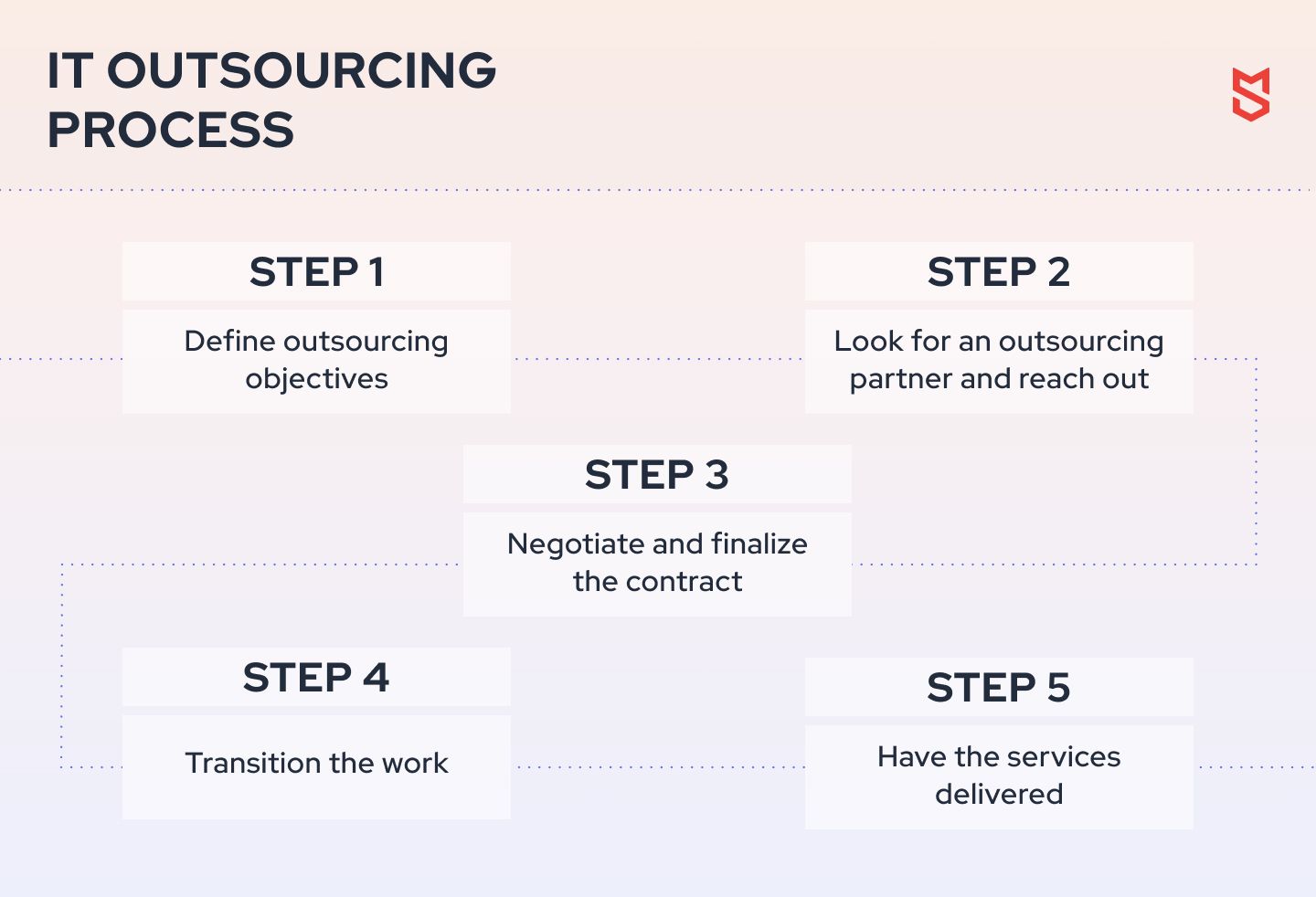
Let’s say you’ve already determined that the IT outsourcing option suits your project. Where do you go from here? In Mind Studios’ experience, the outsourcing process usually goes as follows.
Step 1. Define outsourcing objectives
First and foremost, business executives need to identify the goals and objectives they plan to reach as a result of outsourcing, as well as the budget for the project. After that, it will be easier to define the requirements for the outsourcing partner, such as the team’s experience, expertise, cost, types of services provided, etc.
Step 2. Look for an outsourcing partner and reach out
Now, based on the list of requirements, it’s time to look for a prospective IT outsourcing provider. The most common platforms to look for one are Clutch and GoodFirms. However, networking and reaching out to fellow business owners in your focus industry and asking for a recommendation can also be quite effective.
Once you create a shortlist of suitable candidates, your team can contact them, ask for references, set up interviews, and select the most suitable company.
Step 3. Negotiate and finalize the contract
As a rule, after you’ve presented your project idea, the potential outsourcing provider prepares an offer with the scope of work, the development strategy, pricing, and other outsourcing arrangements.
At this point, your team can negotiate the terms and conditions of the contract, discuss aspects like NDA terms, communication guidelines, termination clauses, and finalize the contract once everything suits both parties.
Step 4. Transition the work
When the contract is signed, and an NDA protects your data, you can start transferring IT functions to your outsourced team. This might include data migration, setting up communication channels, conducting onboarding, and so on. The steps here usually differ depending on the cooperation model.
Step 5. Have the services delivered
All that’s left to do here is delegate the tasks you’ve hired the team for and monitor the performance, service quality, and concordance with the contract terms. During this step, the client and their in-house team can be involved as much or as little as they want.
The challenges of IT outsourcing — and how to deal with them
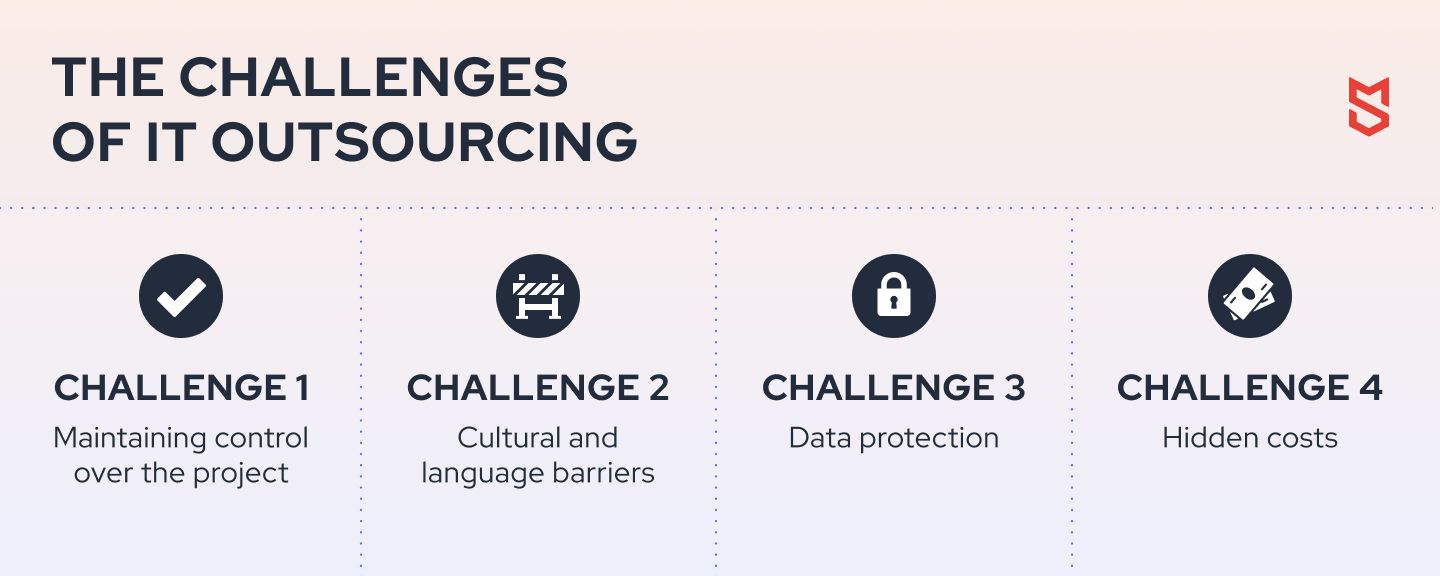
No approach to software development is 100% perfect, and IT outsourcing is no exception. Working with external teams, especially remote ones, comes with certain challenges. However, as a company with a decade of experience providing outsourcing services, Mind Studios has learned to navigate around them.
Here, we share the most common IT outsourcing challenges — and how you can overcome them.
Challenge 1. Maintaining control over the project
While during the pandemic most businesses have gotten used to managing remote teams, outsourcing software development to a company in a different geographic zone can cause doubt regarding management efficiency. So, how to deal with these fears?
Firstly, you can partner with an onshore or nearshore service provider if in doubt. The team still might be remote, but proximity to the outsourced company will make regular meetups possible.
However, if you are considering outsourcing to cut costs, an offshore team might be a better solution. That is why our second advice is to establish communication and reporting guidelines from the very beginning.
Do you want to have online calls on a daily or weekly basis? Will communication with the project manager be enough, or do you want to communicate directly with the team? Which development methodology do you prefer? Don’t hesitate to make arrangements that will make you feel comfortable.
Challenge 2. Cultural and language barriers
Different time zones are not the only obstacle that might arise while working with a remote outsourcing company. Different cultural backgrounds, as well as language barriers, can lead to misunderstandings and therefore decrease the effectiveness of the whole cooperation.
The solution here is to choose a team with adequate knowledge of English and successful cases of developing products for businesses from different countries. For instance, at Mind Studios, we’ve delivered products for companies from all over the world, including businesses from the US, Western Europe, the Middle East, and Asia.
In our experience, when it comes to software development, different cultural backgrounds don’t affect the project as much as the clash of fundamental values, which can happen even between two parties from the same country.
The alignment of your and your outsourced partner’s values plays a crucial role in building a successful product. For instance, you can hire a yes-man who will simply follow the instructions without getting truly invested. Or you can go with a partner who will not be afraid of challenging your ideas and as a result, will bring even more value to your product.
So, when outsourcing, make sure you and the outsourced company are in sync in terms of your approach to conducting business to secure the future success of your project.
Challenge 3. Data protection
Surely, it can be risky to share sensitive data with a third party, especially one you’ve just come to know. However, according to Verizon, 82% of data breaches involve the human element, and that is why companies are never fully protected, even when working with in-house teams exclusively.
Still, businesses can bring those risks to a minimum by signing an NDA with both employees and external vendors. You can also make sure that your and your customers’ data is stored and shared securely by sticking to the latest data protection standards like GDPR, CCPA, and so on.
Challenge 4. Hidden costs
The cost of software development services can be tough to calculate with 100% precision, especially with startup projects without a clearly defined business model and development strategy. This often leads to unexpected expenses in addition to initial estimates.
Nonetheless, it is possible to avoid most hidden costs. We recommend being transparent about the budget limitations from the very first meeting with your prospective outsourcing partners. Transparency and honesty help outsourced companies stay mindful of their clients’ resources and adjust their strategies to meet the initial estimates.
Mind Studios’ approach
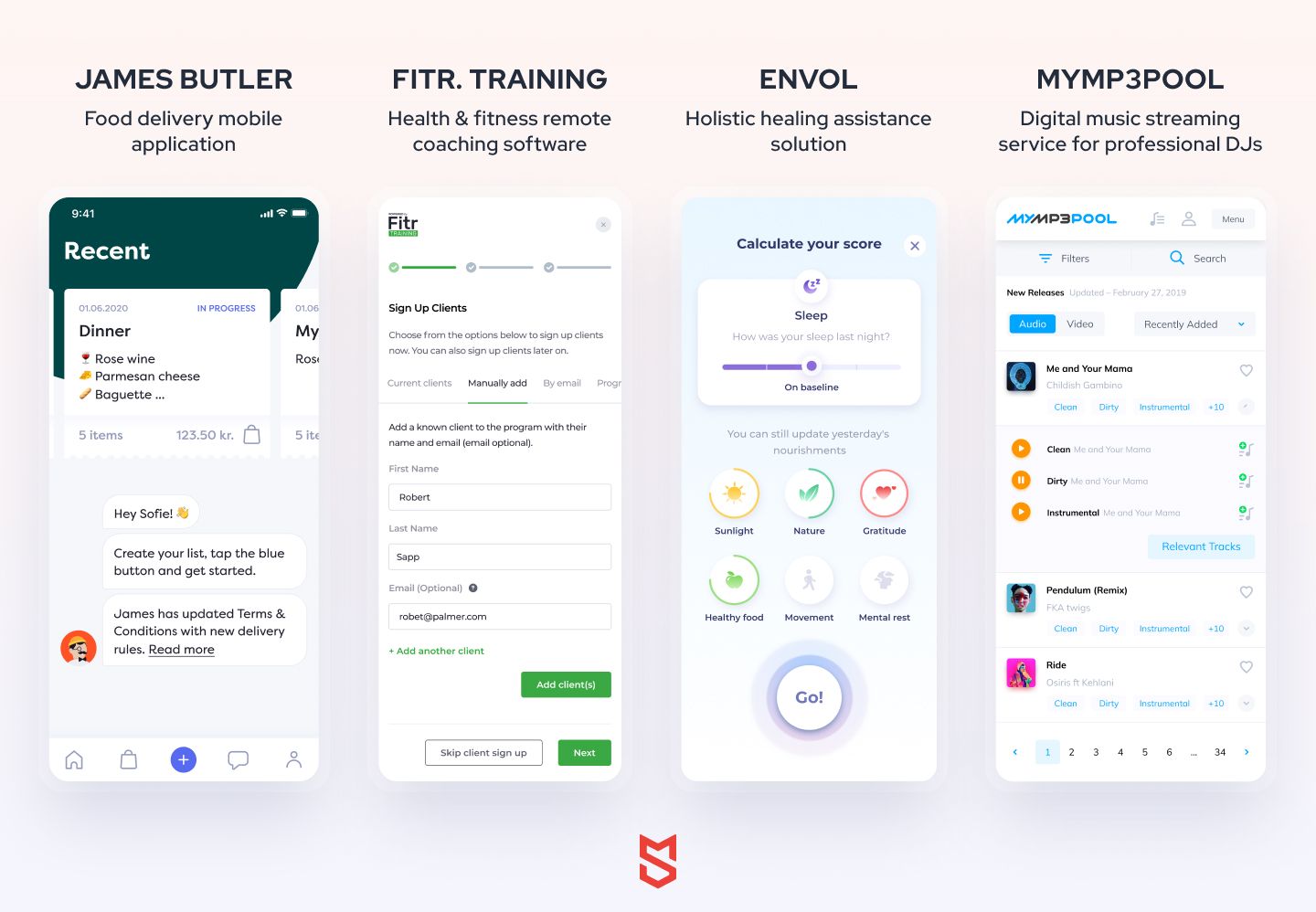
Fears and doubts that surround IT outsourcing haven’t appeared out of thin air. They often come from real-life experiences and can be completely valid.
Still, development and cooperation strategies within IT outsourcing industry are constantly evolving. For this article, we talked to Anton Baryshevskiy, Mind Studios’ co-founder and chief business development officer, to discuss businesses' most common concerns about outsourcing and how our team addresses them.
“The biggest fear the clients have about outsourcing is not having enough control over the project. And it is completely valid and understandable once you put yourself in their shoes.
Imagine you’re renovating your house and ordering the furniture from a remote manufacturer you’ve never encountered in real life. After placing the order, you will feel anxious without getting regular updates on its status.
Now imagine ordering costly software services with an upfront payment from a company located in another country or even continent. It’s natural for the clients to want to constantly keep in touch and get informed about what’s going on with their project.”
Mind Studios gets how the clients feel in these situations. Therefore, we do everything possible to help them make an informed decision before signing a contract with us. For instance, we are happy to connect them with our previous clients, especially those in the same field, who can share their honest opinions about working with us.
We are also ready to establish direct contact with the development team to help achieve the highest level of efficiency. Therefore, when working with our dedicated teams, the clients can discuss UI/UX solutions with the designers, reach out to the developers, or arrange for our project managers to collaborate with their marketing team.
All this usually happens within the Slack project we set up, which allows the clients to always have access to the team working on their projects.
We also set clear communication guidelines depending on how much the clients want to be involved in the development process. For instance, some partners prefer weekly meetings, some are more comfortable with daily sync-ups, and others request turn-key solutions with reports every two weeks.

The next fear we often address comes from negative experiences with outsourcing.
“We’ve had cases where clients worked with IT outsourcing companies that built solutions based on third-party templates. Mind Studios specializes in building custom solutions from scratch, providing our clients with a proprietary right to them.”
This means that after we’ve completed the project, the client becomes the owner of the source code we wrote, and it cannot be reused for other projects. For startups, this approach is crucial since it gives them a significant advantage when presenting the product to prospective investors.
Anton brings up one more important detail about outsourcing experience some clients have.
“Sometimes our clients share positive feedback about previous cooperations with outsourcing partners and jobs they did but mention that the project didn’t become successful for some reason. And that’s a problem.
Mind Studios follows a product-oriented approach, meaning that before getting down to development, we ensure the idea is feasible and can succeed. Our meticulous approach to the discovery phase and ability to challenge our clients’ ideas if we see a better solution allows us to significantly lower the product’s failure odds.”
For our team, an IT outsourcing company is not a technical vendor but a technical partner aimed at developing products that become viable and profitable.
Conclusion
It’s hard to argue that having an in-house tech team is the most efficient way to build software products. However, it doesn’t always make financial sense to retain one, especially in the times of recession and other economic challenges. That’s why IT outsourcing is becoming increasingly popular with both big enterprises and small businesses.
Luckily, as you probably have learned from this article, outsourcing doesn’t mean settling purely out of financial necessity. If anything, it can open even more opportunities. We at Mind Studios know for sure that it is possible to find a reliable outsourcing team that would make it their mission to help you reach the desired business goals through software solutions.
Hopefully, this article has helped you get a better idea of which outsourcing type could suit your needs. However, even if you are still hesitant, our business development consultants would be happy to help with finding the best development strategy. So, reach out, and we’ll schedule a free consultation for you shortly.



![How to Create an On-Demand Medicine Delivery App [Expert Guide]](https://themindstudios.com/blog/content/images/size/w600/2025/03/IMG-1-Cover-6.jpg)




